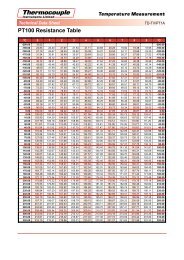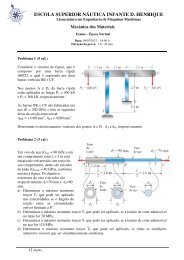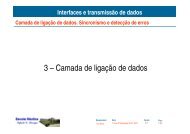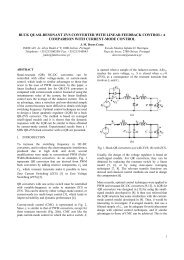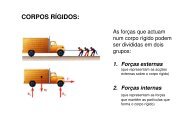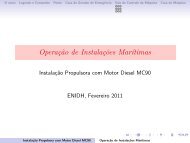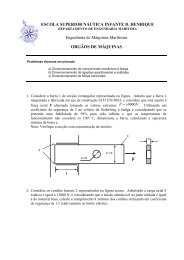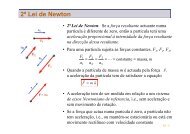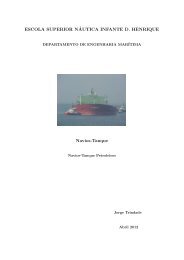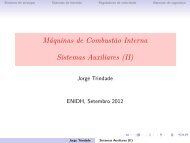Textos de Apoio (pdf)
Textos de Apoio (pdf)
Textos de Apoio (pdf)
Create successful ePaper yourself
Turn your PDF publications into a flip-book with our unique Google optimized e-Paper software.
Shaft power<br />
% SMCR<br />
105<br />
100<br />
95<br />
90<br />
85<br />
80<br />
4<br />
Engine "propeller curve"<br />
Propeller curve<br />
Propeller curve<br />
96 97 98 99 100 101 102 103 104 105 % SMCR<br />
(Logarithmic scales)<br />
Propeller/engine speed<br />
over a period of one year and only<br />
inclu<strong>de</strong>s the influence of weather conditions!<br />
The measuring points have<br />
been reduced to three average weather<br />
conditions and show, for extremely bad<br />
weather conditions, an average heavy<br />
running of 6%, and therefore, in practice,<br />
the heavy running has proved to<br />
be even greater.<br />
In or<strong>de</strong>r to avoid slamming of the ship,<br />
and thereby damage to the stem and<br />
racing of the propeller, the ship speed<br />
will normally be reduced by the navigating<br />
officer on watch.<br />
Another measured example is shown<br />
in Fig. 14, and is valid for a reefer ship<br />
during its sea trial. Even though the<br />
wind velocity is relatively low, only 2.5<br />
m/s, and the wave height is 4 m, the<br />
SMCR: 13,000 kW x 105 r/min<br />
Wind velocity : 2.5 m/s<br />
Head wind<br />
Wave height : 4 m<br />
Tail wind<br />
SMCR<br />
*22.0<br />
7<br />
5<br />
22.3 *<br />
1<br />
Propeller <strong>de</strong>sign<br />
light running Heavy<br />
running<br />
20.5 21.8<br />
** 20.5 *<br />
21.5<br />
*<br />
20.8*<br />
* 21.1 3<br />
21.1 *<br />
*21.2<br />
Fig. 14: Measured relationship between power, propeller and ship speed during seatrial of<br />
a reefer ship<br />
measurements indicate approx. 1.5%<br />
heavy running when sailing in head<br />
wind out, compared with when sailing<br />
in tail wind on return.<br />
Ship acceleration<br />
When the ship accelerates, the propeller<br />
will be subjected to an even larger<br />
load than during free sailing. The power<br />
required for the propeller, therefore, will<br />
be relatively higher than for free sailing,<br />
and the engine’s operating point will be<br />
heavy running, as it takes some time<br />
before the propeller speed has reached<br />
its new and higher level. An example<br />
with two different accelerations, for an<br />
engine without electronic governor and<br />
scavenge air pressure limiter, is shown<br />
in Fig. 15. The load diagram and scavenge<br />
air pressure limiter are is <strong>de</strong>scribed<br />
in Chapter 3.<br />
Shallow waters<br />
When sailing in shallow waters, the residual<br />
resistance of the ship may be increased<br />
and, in the same way as when<br />
the ship accelerates, the propeller will<br />
be subjected to a larger load than during<br />
free sailing, and the propeller will be<br />
heavy running.<br />
Influence of displacement<br />
When the ship is sailing in the loa<strong>de</strong>d<br />
condition, the ship’s displacement volume<br />
may, for example, be 10% higher<br />
or lower than for the displacement valid<br />
for the average loa<strong>de</strong>d condition. This,<br />
of course, has an influence on the ship’s<br />
resistance, and the required propeller<br />
power, but only a minor influence on<br />
the propeller curve.<br />
On the other hand, when the ship is<br />
sailing in the ballast condition, the displacement<br />
volume, compared to the<br />
loa<strong>de</strong>d condition, can be much lower,<br />
and the corresponding propeller curve<br />
may apply to, for example, a 2% “lighter”<br />
propeller curve, i.e. for the same power<br />
to the propeller, the rate of revolution<br />
will be 2% higher.<br />
Parameters causing heavy running<br />
propeller<br />
Together with the previously <strong>de</strong>scribed<br />
operating parameters which cause a<br />
heavy running propeller, the parameters<br />
summarised below may give an indication<br />
of the risk/sensitivity of getting<br />
a heavy running propeller when sailing<br />
in heavy weather and rough seas:<br />
1 Relatively small ships (


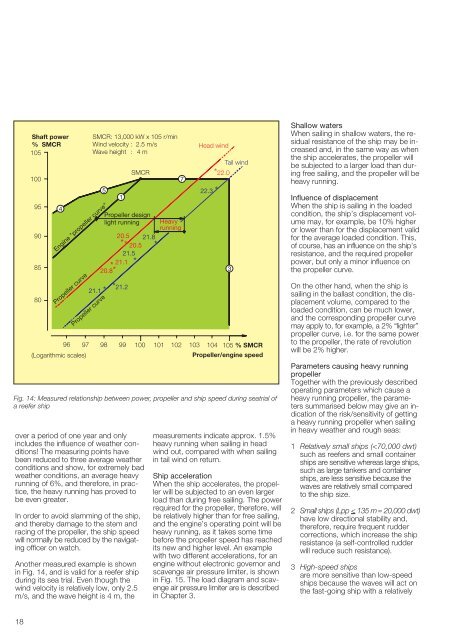
![Conceitos transmissao de dados .Sinais[.pdf]](https://img.yumpu.com/50982145/1/190x146/conceitos-transmissao-de-dados-sinaispdf.jpg?quality=85)
![Packages e interfaces[.pdf]](https://img.yumpu.com/50629553/1/190x134/packages-e-interfacespdf.jpg?quality=85)
